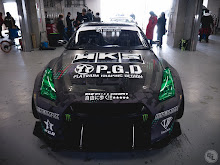Here’s one of those never-ending debates. When it comes time to select a touring car chassis for drifting, one of the decisions you’ll have to make in the process is simple: shaft or belt drive? What’s the cost difference? Does one perform better? What are the pro’s and cons of each? Since this is always a hot topic, I’ve decided to offer my knowledge to weigh out both drivetrain types.
Explanation: Define both drivetrain types?
Shaft Drive: A shaft-driven AWD touring car chassis usually transmits power to both axles via a main driveshaft that runs along the centerline of the chassis. The power movement is as follows: motor to pinion gear -> pinion to spur gear -> spurgear is mounted to center driveshaft -> center driveshaft meshes to the front and rear differentials via conical gear that is attached to the differential.
Belt Drive: A belt-driven AWD touring car chassis usually transmits power to both axles via 1 or more (usually 2) drive belts that run along the centerline of the chassis. The power movement is as follows: motor to pinion gear -> pinion to spur gear -> spurgear is mounted to a layshaft, with a pulley attached to it -> center pulley has 2 belts rotating around it -> each belt transmits power to the front and rear differentials via belt pulley that is part of the differential.
What’s good and bad about shaft-driven chassis for drifting?
GOOD #1. Shaft cars are usually suggested to beginners to RC drifting simply because they generally cost less (new vs. new), so it’s easier to get into RC drifting if you don’t have to pay as much. Tamiya’s TT-01 is an example of a commonly suggested shaft-driven chassis.
GOOD #2. Shaft cars have more enclosed drivetrains, which is better since most RC drifting is done on unprepared surfaces with pebbles and dust, etc. stuff that can ruin ball bearings and diffs, etc.
GOOD #3. With shaft cars you don’t have to deal with belt tension, frayed belts, skipping teeth, and any other possible problems related to a belt-driven chassis.
GOOD #4. Some can argue that shaft cars are more ‘direct’ in that there’s a solid transfer between motor to pinion to spur to gear to shaft, etc. whereas there’s arguments regarding belts stretching at first trigger pull.
BAD #1. Here’s the bad part about shaft-driven chassis – torque steer. If you look at my drawing below:
As you can see, shaft-driven chassis transfer motor torque (1) laterally. When using a high-powered motor, this will ‘twist’ the chassis because the motor’s torque if overpowering the suspension. The spur gear (2) and main driveshaft (3) then spin in the opposite direction (so motion, in turn, has just changed direction), and then motion changes direction once more 90-degrees to the front and rear diffs (4). Momentum is lost with each change in direction. Since this directional change is happening laterally (side to side) then it’s almost like the motor is rocking the chassis side-to-side. This means that at a certain point in time, more torque/weight will favor one side of the chassis over the other. This can easily cause torque steer because weight transfer affects how much traction each tire has. If you rock the car to the left, then the right side tires will lose traction, and vice versa.
To put it simply, on shaft cars the motor itself is sitting inline, thus whenever you pull the trigger, motor torque is transferred left-to-right, or vice versa. This effect is felt more with mod motors, is inherent to all shaft cars, and produces unwanted torque steer.
What’s good and bad about belt-driven chassis for drifting?
GOOD #1. Belt cars transfer motor torque inline with the chassis movement. This does not give the chassis any ‘torque steer’ which is common with shaft cars since the direction of movement is similar, e.g. motor spins forward, wheels rotate forward. motion doesn’t change direction except once (pinion to spur.) Look at my drawing below.
(1) Pinion gear rotates spur gear, motion changes from going backward to going forward (2). The layshaft pulley (3) moves forward, rotating both drive belts (front and rear) forward as well. Motion is still the same once the belts reach both diffs (4).
GOOD #2. Belt cars run smoother and quieter, plus there’s less drivetrain loss because there’s less drivetrain weight overall (belt weight vs. shaft weight)
GOOD #3. Some belt cars (i.e. TA-05) move the motor closer to the center of the car (more centerd between the front and rear axles) for better balance (especially when going sideways), whereas shaft cars almost always have the motor biased toward the rear.
GOOD #4. Here’s more 3 reasons to consider that makes belt-driven chassis overall more ‘superior’ to shaft cars: Mark Rheinard, Atsushi Hara, and Masami Hirosaka. All three are multiple world champions (Tamiya, Hot Bodies, and Yokomo, respectively) in the RC touring car racing world… and all of them drive belt-driven cars.
BAD #1. The problems with belt-driven chassis are belts that will stretch over time (requiring belt tension adjustment or belt replacement. Also, since the pulleys aren’t usually enclosed (like the differentials on a shaft-driven chassis are), pulleys are prone to sucking up rocks or pebbles in between the pulley teeth.
——————————-
UPDATED:
Both platforms are capable for drifting. As shown bove, each style has their own advantages and disadvantages. Shaft driven drift-specific vehicles these days are much better compared to “touring cars converted to drift just by changing the tires” cars. On the other hand, high-end drift-specific belt driven machines are coming into vogue, such as Tamiya’s VDF. Talk to other drifters, visit a local track, see if you can drive both styles and select belt or shaft based on your findings


